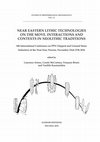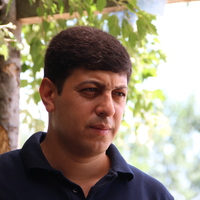Papers by Bastien Varoutsikos
Asian Affairs, 2023
This paper provides a preliminary overview of the state of cultural heritage in Nuristan, Afghani... more This paper provides a preliminary overview of the state of cultural heritage in Nuristan, Afghanistan, following the authors fieldwork in this area in 2022.
Forum PBC, 2023
Les destructions du patrimoine culturel au cours des 20e et 21e siècles ont toujours déclenché le... more Les destructions du patrimoine culturel au cours des 20e et 21e siècles ont toujours déclenché le développement de nouvelles stratégies de protection, allant d'outils juridiques à la création d'organisations de subventionnement. La Fondation Alliance internationale pour la protection du patrimoine dans les zones de conflit (Fondation ALIPH) a été créé par une alliance de pays et de donateurs privés réunis en 2017 à l'initiative de la France et des Émirats arabes unis, spécifiquement dédiée au soutien de projets patrimoniaux dans les zones de conflit, de post-conflit et de crise.
The Neolithic Settlement of Aknashen (Ararat valley, Armenia) Excavation seasons 2004-2015, 2022
This paper relies on techno-typological analysis of a series of collections in the South Caucasus... more This paper relies on techno-typological analysis of a series of collections in the South Caucasus and the Near East to shed light on the possible parallels between the material culture of the Neolithic site of Aknashen, Armenia and other settlement in the region.

The site of Bavra-Ablari is a Mesolithic-Chalcolithic rock shelter, located on the Javakheti plat... more The site of Bavra-Ablari is a Mesolithic-Chalcolithic rock shelter, located on the Javakheti plateau in the valley of a tributary of the Kura River, in southern Georgia. Excavations have been carried out by a Georgian-French team since 2012 and have shed light on pro-cesses that took place during the Early Holocene. The Mesolithic layer of the site shows an occupation, not yet fully excavated, which will provide important chrono-cultural infor-mation about the exploitation of the mountainous areas during the ninth millennium BCE. The Neolithic occupation chronologically matches the first evidence of agricultural society in the Near East during the sixth millennium BCE, and is characterised by a combination of Neolithic and Mesolithic features. The Chalcolithic layer produced a significant collec-tion of material that supports a re-occupation of the highlands during the fifth millennium, as well as the development of subsistence strategies adapted to this environment. Non-final proof.
The Neolithic Settlement of Aknashen (Ararat valley, Armenia) Excavation seasons 2004-2015, 2022
This study is an techno-typological and functional analysis of the lithic assemblage of the Neoli... more This study is an techno-typological and functional analysis of the lithic assemblage of the Neolithic site of Aknashen, Armenia. It is an important step in providing a well dated cultural and behavioral sequence for the entire region, and will prove increasingly helpful as other assemblages from recently excavated sites across the Caucasus are published.

This article presents the preliminary results of the analysis of the obsidian collection from the... more This article presents the preliminary results of the analysis of the obsidian collection from the Chalcolithic settlement of Dava Göz in northwestern Iran. Dava Göz is one of the few settlements in this area that has been excavated using modern techniques, and has provided new information on the development of the communities in the Lake Urmia basin from the sixth to the fourth millennia BCE (5400–3700/3600 BCE), including the Neolithic/Transitional Chalcolithic (Period IA), the Early Chalcolithic (Dalma = Period IB) and the Late Chalcolithic (Pisdeli = LC1 = Period II; Chaff-Faced Ware horizon = LC2 = Period III) phases. The analysis of the settlement's material culture also enables some preliminary conclusions regarding the interactions between the groups situated north of Lake Urmia and the contemporary Caucasian cultures, as well as with those located farther west and south, in eastern Anatolia and in the Syro-Mesopotamian region. The characterization of 126 artifacts from three periods using a portable XRF machine indicates throughout the phases that changes occurred in procurement activity. In the earlier phases (Transitional Chalcolithic and Dalma), procurement more closely resembles a polysource pattern, dominated by one main obsidian outcrop and complemented by several, less represented sources of that raw material. This pattern however appears to change in the later phase of the site's occupation (LC2/CFW) where a clear domination of one obsidian source is represented. This development could be connected to a disruption in procurement networks and most probably in transhumance patterns as well.

Although there is no clear consensus regarding the origins of agriculture in the Southern Caucasu... more Although there is no clear consensus regarding the origins of agriculture in the Southern Caucasus, local and international research have offered an increasingly clearer understanding and chronology of the phenomenon. Few sites are known directly prior to the first Neolithic settlements, identified in the Kura and Araxes valley as full-blown agricultural communities at the very beginning of the 6th millennium cal. BC. Evidence currently point towards a role played by Near Eastern groups bringing in various types of agricultural packages along the main river valley axes. The role of local communities from the Southern Caucasus in this process is poorly known, and the Near-Eastern hypothesis still need supporting evidence. In this study, we look at a particular type of lithic production, a blade-making tradition ubiquitous across the Aratashen-Shulaveri-Shomutepe assemblages, through the collection of Aknashen, an Armenian Neolithic settlement. The technical and raw material requirement identified at Aknashen allows us to shed light on the mechanisms of diffusion of the Neolithic within the region, as well as its potential origin.

Journal of Archaeological Science: Reports, 2018
This article presents the preliminary results of the analysis of the obsidian collection from the... more This article presents the preliminary results of the analysis of the obsidian collection from the Chalcolithic settlement of Dava Göz in northwestern Iran. Dava Göz is one of the few settlements in this area that has been excavated using modern techniques, and has provided new information on the development of the communities in the Lake Urmia basin from the sixth to the fourth millennia BCE (5400-3700/3600 BCE), including the Neolithic/Transitional Chalcolithic (Period IA), the Early Chalcolithic (Dalma = Period IB) and the Late Chalcolithic (Pisdeli = LC1 = Period II; Chaff-Faced Ware horizon = LC2 = Period III) phases. The analysis of the settlement's material culture also enables some preliminary conclusions regarding the interactions between the groups situated north of Lake Urmia and the contemporary Caucasian cultures, as well as with those located farther west and south, in eastern Anatolia and in the Syro-Mesopotamian region. The characterization of 126 artifacts from three periods using a portable XRF machine indicates throughout the phases that changes occurred in procurement activity. In the earlier phases (Transitional Chalcolithic and Dalma), procurement more closely resembles a polysource pattern, dominated by one main obsidian outcrop and complemented by several, less represented sources of that raw material. This pattern however appears to change in the later phase of the site's occupation (LC2/CFW) where a clear domination of one obsidian source is represented. This development could be connected to a disruption in procurement networks and most probably in transhumance patterns as well. 2.1. Obsidian studies Obsidian is a material widely used by prehistoric groups and found in abundance on archaeological sites in the Taurus-Zagros region. Provenance studies have been the focus of intense research and debate among archaeologists and geologists over the past 60 years, especially those focusing on the Anatolian plateau and the Caucasus. However, obsidian studies in Iran have remained in an early stage, and only recent research on obsidian outcrops, carried out in parallel with prehistoric obsidian provenance studies, has provided the first opportunity to develop a database (Abedi et al., 2017; Khademi Nadooshan et al., 2013; Abedi, 2015) and to outline a horizon and a perspective for

Quaternary International, 2016
The socioeconomic processes during the Late Neolithic in northern Greece have been given little a... more The socioeconomic processes during the Late Neolithic in northern Greece have been given little attention compared to earlier phases of this period. However, several studies suggest interesting phenomena such as shifts in settlement patterns and ceramic production, possibly entailing processes of intense group interactions and increasing territorialization. However, these processes have only been addressed through the lens of pottery production, thus only looking at a limited aspect of the economic evolution of these groups. Acknowledging the potential of technological analysis to shed light on such socioeconomic processes, this paper focuses on a lesser known type of material, rock-crystal. The study presents recent archaeological and experimental results on knapped rock-crystal taking place during the Late Neolithic in northern Greece. This study emphasizes the need for a new methodological framework to address this type of raw material, while providing a new approach to lithic production and consumption on Neolithic sites. This analysis is a preliminary step towards a reconsideration of the issues associated with the identification of pressure knapping techniques both on rock crystal, and other types of raw material. The presence of technical pieces, flakes, debris and cores within these assemblages questioned the possibility of a "local" pressure debitage in a regional and chronological context where the products of a pressure blade manufacture are generally considered imported and almost exclusively present, on consumer sites, in the form of finished products (unretouched and/or retouched blades).
September 2016 Conference: Quatrième rencontre scientifique du groupe Res-HistAt, 2016

June 2014: The DGAM have worked to digitise the records and plans of 1500 castles, museums, archa... more June 2014: The DGAM have worked to digitise the records and plans of 1500 castles, museums, archaeological sites and mosques in province of Aleppo. 6 Dec 2014: They have created a database of icons from Syrian Churches to help preserve and reduce trafficking of stolen icons/archaeological finds from churches. 7 Mar 2015: More than 1000 files for built cultural heritage have been digitised, to preserve the original archive at risk of damage due to the crisis. Files include historic documents, maps and building blueprints. 8 June 2015: According to the DGAM presentation at the Strategies for Restoration and Reconstruction: Museums, Heritage Sites and Archaeological Parks in PostWar Countries Conference (Bern, 25 June 2015), the DGAM have created a database of sites and are recording the damage to them. Files are available as Google Earth.kmz and GIS shapefiles, and on the website. By the end of 2015 they aim to have 160 000 electronic records, and 150 000 objects will have been photographed. 9 July 2015: The DGAM reported on the progress of their "centralized database of archaeological archives" of the DGAM in Damascus. It combines the databases of the Syrian museums and of archaeological sites, which are listed in GIS-based maps. So far, around 134,000 objects from the museums of Damascus, Palmyra, Aleppo and Hama are integrated in the database. Work on the data of the Damascus old city, Damascus Citadel and Bosra is completed. A 'unified cataloguing system of museums objects in Syria' was made available in 2012 in English and Arabic. A looted objects database is currently being developed. Data is open to researchers and editors. The output of GIS documentation will be produced as site maps, risk and damage map. All information is electronically published. 10 6 DGAM Website.
Modern media strategies are a perfect fit for iconoclastic urges such as the ones currently witne... more Modern media strategies are a perfect fit for iconoclastic urges such as the ones currently witnessed in Syria and Iraq. Anyone with a Facebook profile should consider the images of destruction they share on social media
présentation d'une base de données en ligne présentant les données géologiques et archéologiques ... more présentation d'une base de données en ligne présentant les données géologiques et archéologiques sur l'obsidienne au proche orient.
A look into the universalist roots of the World Heritage concept following WWII, and an overview ... more A look into the universalist roots of the World Heritage concept following WWII, and an overview of the various type of destructions taking place around the world.
Éléments d'informations sur la Néolithisation du Caucase à travers les fouilles de l'abri sous-ro... more Éléments d'informations sur la Néolithisation du Caucase à travers les fouilles de l'abri sous-roche de Bavra-Ablari, Géorgie.








Uploads
Papers by Bastien Varoutsikos